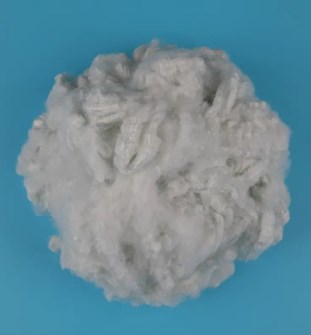Product Consultation
Your email address will not be published. Required fields are marked *
In the modern textile industry, hollow conjugated fiber is gaining increasing attention globally due to its superior functionality and excellent physical properties. As a high-performance fiber material, it not only demonstrates unique value in apparel, home textiles, and industrial applications but has also become an important choice for environmental protection and sustainable development.
The Unique Structure of Hollow Conjugated Fiber
Hollow conjugated fiber is a fiber with a special structure, formed by combining two or more different polymers through melt co-extrusion technology. Its interior is hollow, while the outer layer is a tough fiber wall structure. This structure not only gives the fiber its lightweight properties but also creates natural insulation, bulkiness, and elasticity.
Through scientific design, hollow conjugated fibers can achieve various cross-sectional shapes, including circular, hollow star, and trefoil shapes. These cross-sectional shapes directly affect the fiber's warmth, feel, and processing performance. Compared to traditional solid fibers, hollow conjugated fibers achieve a good balance between weight and comfort, providing more possibilities for high-end textiles.
Superior Insulation and Lightweight Performance
One of the most significant advantages of hollow conjugated fiber is its excellent insulation. Its hollow structure allows for the formation of air layers within the fiber, effectively reducing heat conduction and thus maintaining warmth without adding extra weight. This makes it highly competitive in winter clothing, outdoor gear, and as a down alternative.
Simultaneously, the fiber's lightweight nature results in fabrics that are soft and elastic, providing a more comfortable wearing experience. This lightweight property not only enhances the wearability of clothing but also reduces transportation costs and energy consumption, meeting the requirements of sustainable development in modern textiles.
Excellent Moisture Wicking and Breathability
Another major advantage of hollow conjugated fiber is its excellent moisture-wicking ability. The microporous structure within the fiber quickly absorbs and releases moisture, keeping the skin dry. This function is particularly important in sportswear and close-fitting garments, effectively improving wearing comfort and the overall experience.

The hollow structure also provides excellent breathability, allowing air to flow freely between the fibers. This not only increases the softness of the fabric but also reduces stuffiness, an indispensable performance indicator for high-performance clothing.
Exceptional Elasticity and Resilience
Hollow conjugated fiber exhibits superior elasticity and resilience through a rational polymer combination and cross-sectional design. This characteristic allows the fabric to maintain its original shape even after prolonged use, reducing deformation and sagging. Simultaneously, the fiber's inherent structural advantages ensure excellent durability during daily friction and washing, extending product lifespan.
The fiber's high elasticity and resilience not only enhance wearing comfort but also provide greater freedom in garment manufacturing processes, meeting the high demands of fashion designs for fabric flexibility and three-dimensionality.
Environmental and Sustainable Development Advantages
With global emphasis on environmental protection and sustainable development, hollow conjugated fiber is demonstrating its green value. Many manufacturers choose to use recyclable polymers and produce hollow conjugated fibers through low-energy co-extrusion processes, thereby reducing environmental impact. The fiber's lightweight design also means energy and resource savings in logistics and processing.
The fiber's high durability and long service life reduce textile waste to some extent, contributing to the goal of a circular economy. In the international market, this environmental advantage has become a key selling point for exporters and brand owners.
Potential for Multiple Applications
Hollow conjugated fiber's functional and structural advantages make it widely applicable across various fields. In apparel, it's used in down substitutes, high-performance sportswear, winter thermal wear, and lightweight cold-weather gear. In home textiles, it enhances the warmth and softness of comforters, pillow fillings, and sofa stuffings. In industrial and technical textiles, hollow conjugated fiber can also be used in filter materials, insulation materials, and shock-absorbing fillings, fully demonstrating its versatility.
This cross-sectoral application capability not only enhances the market value of hollow conjugated fiber but also provides foreign trade enterprises with richer export opportunities and product portfolio strategies.
With its unique hollow structure, multifunctional properties, and environmental advantages, hollow conjugated fiber has become an important material in the modern textile industry. It not only meets multiple performance requirements such as lightness, warmth, comfort, and breathability but also aligns with the global trend of sustainable development. In the apparel, home textile, and industrial textile sectors, hollow conjugated fiber demonstrates strong market potential and export value.
Your email address will not be published. Required fields are marked *
Focusing to the research and production of differentiated fiber. Applying recycle-material processing scientifically.
Zhulinjizhen, Xinfeng Town, Jiaxing City, Zhejiang Province
Copyright @ 2023 Jiaxing Fuda Chemical Fiber Factory All rights reserved
Polyester Staple Fiber Manufacturers
Friendship link - Anhui Fulin Environmental Protection Technology Co., Ltd.:https://www.ahflhb.com
